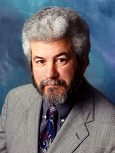 It's obvious.
It's obvious.
It affects more than 10 million people in our nation - mostly women. Unfortunately, fewer than one quarter of these individuals know it.
We see it in friends, co-workers and family members. It results in loss of self-esteem, diminished mobility, fractures, disability and even death.
We literally watch it develop progressively over the years. Yet rarely do we insist on, or receive treatment until it's too late.
The problem is osteoporosis, a rather common bone disease that affects older women and men. In March 2000, the National Institutes of Health (NIH) panel defined it as "a skeletal disorder characterized by compromised bone strength predisposing to an increased risk of fracture."
Although sometimes referred to as a "silent" disease, in many cases it's easy to spot. Individuals with osteoporosis often cannot stand straight. They also experience progressively shortened stature and a hunchback appearance. Dowager's hump, a protrusion at the base of the neck also frequently occurs.
Yet despite these obvious features, many people go untreated until a devastating hip fracture occurs that often leads to disability. Sometimes the diagnosis is heralded by back pain, collapsed vertebrae and spinal nerve involvement. By then, it may be too late.
Since early detection and education are paramount to effective treatment, let's spend a few moments reviewing what is known about this condition.
Two types of Osteoporosis exist. Type I typically affects postmenopausal women between 55 and 75. Type II, affects 70-80 year-old men and women equally. What is described as "bone weakness" typical results from mineral loss or inadequate bone development. According to the NIH, "the bone mass attained early in life is perhaps the most important determinant of life-long skeletal health." Prevention should actually be focused initially on nutrition in childhood.
With the exception of individuals who have a history of kidney stones, suggested calcium and Vitamin D requirements from the National Academy of Sciences are:
-
- Children 3-8: Calcium - 800 mg./day
- Children 9-18: Calcium - 1300 mg./day
- Adults 19+: Calcium 1000 - 1800 mg./day
- Adult (avg.): Vitamin D 500 - 700 IU/day
While the NIH is encouraging research for increasing peak bone mass in childhood, its panel is also emphasizing the unraveling of the genetic components of osteoporosis as well as the discovery of the best individual and combined treatment modalities. Yet from this physician's perspective, there's no time to wait for the medical establishment to become more aggressive - it's up to us to make a difference early on when it counts the most. One of the most frustrating aspects of medicine in our nation centers around the fact that advances in medical research seem to take an inordinate amount of time to reach the people who are in need.
So if you have even the slightest reason to suspect osteoporosis (especially if you are a menopausal or post-menopausal woman), speak with your physician during your next check-up and insist on a bone-density measurement. This is a simple, quick and painless screening procedure that has great value now and in the future. Bone density results not only document where you are today, but can also be used as a comparison for monitoring rates of progression or treatment efficacy.
Basic treatment and prevention options include weight-bearing exercises, calcium and Vitamin D supplementation. Whenever possible, one should avoid substances that promote calcium loss such as aluminum-based antacids, caffeine, carbonated and alcoholic drinks, high protein diets and sodium. It's also a fact that cigarette smoking can cause bone mineral depletion. So if you need just one more reason to quit, there's no better time than NOW!
In many cases basic treatment and prevention options may not be sufficient to prevent osteoporosis. Medications in the form of hormone-replacement therapies and other recently-released osteoporosis drugs can be prescribed. Several options exist.
Miacalcin (generic - Calcitonin), a hormone that prevents bone from breaking down is available as a nasal spray. A single spray in one nostril daily has been shown to be effective. In some cases, nasal dryness and irritation have been reported. When taking Miacalcin or other prescribed agents, remember that adequate intake of calcium and Vitamin D are still essential for effective treatment.
In 1999, more than 3.5 million patients were treated for Osteoporosis with Fosomax (generic - Alendronate). While approximately 10% of patients on Fosomax develop irritation of the esophagus, most tolerate it well.
Evista (generic - Raloxifene) was approved for Osteoporosis by the FDA last fall. Evista appears to be associated with venous blood clots in some patients. However, many women are using this medication without problems. The latest "kid on the block" just released in April 2000 is Actinel (generic - Risedronate) which has demonstrated significant benefits with few side effects when compared with placebos.
It's essential to realize that the treatment of Osteoporosis is in it's infancy and new drugs with fewer side effects are on the horizon. Yet based upon what is known today, it is unwise to take a "wait and see" attitude rather than seeking the best options available today. Speak with your physician, consider your individual circumstances, learn as much as you can, develop healthy eating habits and become an active member on your healthcare team. Since great ways to grow new bone have not yet been discovered, why not preserve what you already have? -- Mind Over Matter!
© 2000 Barry Bittman,
MD all rights reserved
Contact Dr. Bittman